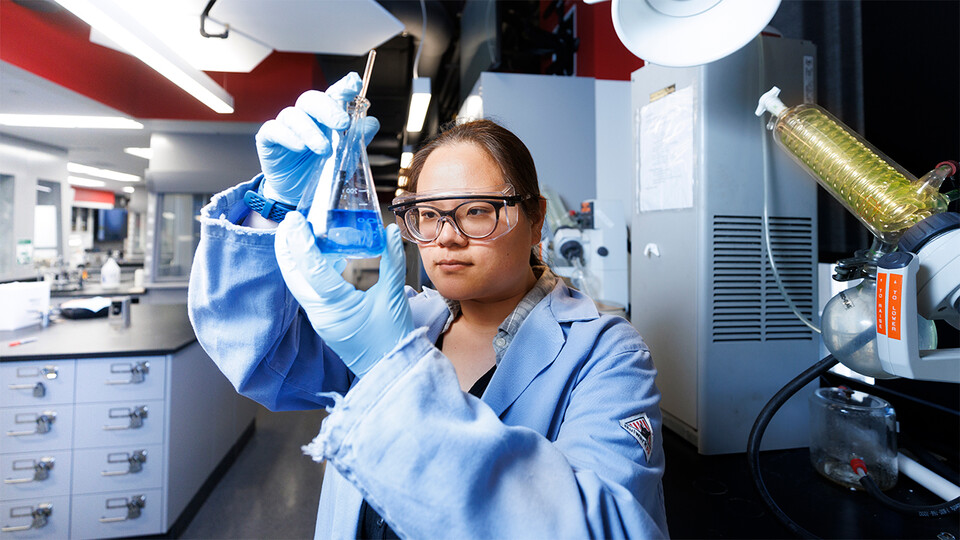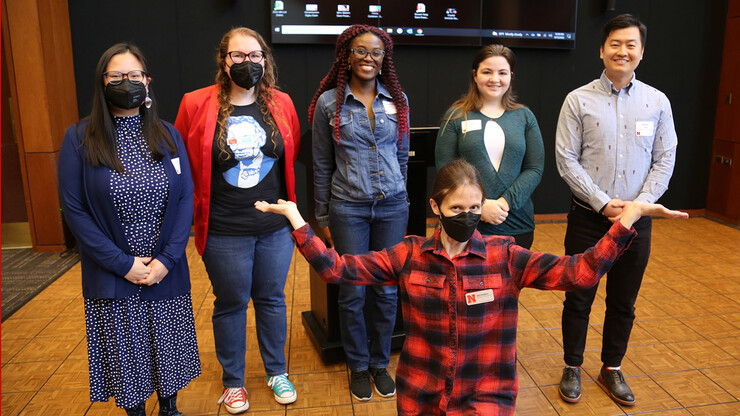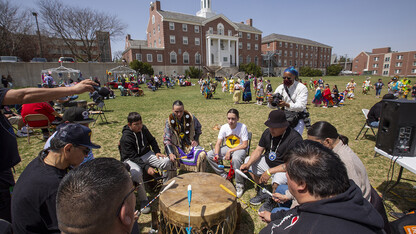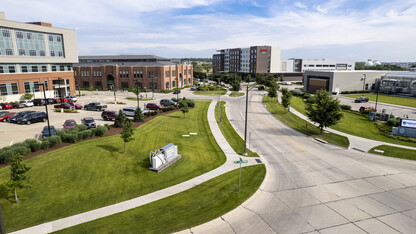· 11 min read
Grad student finds teaching career amid research program

Where’s room 321???
It was the fall semester of 2020, her first day as a graduate teaching assistant in the University of Nebraska–Lincoln's Department of Chemistry, and Wini Waters was… not lost, exactly, but at least unsure of where she was going.
The onset of COVID-19 had limited the in-person, on-site training that Waters’ pre-pandemic predecessors had enjoyed, leaving her less than familiar with the layout of Hamilton Hall. She was seeking the lab where she’d be guiding a cohort of undergrads, none of them chemistry majors, through the basic techniques and instrumentation of organic chemistry — a branch of the field that even tenured faculty sometimes recall with distaste.
In the lead-up to her first week as a TA, some of her fellow grad students had issued Waters a promise that, depending on the messenger, might also have doubled as a warning: You’re either going to love it, they’d said, or you’re going to hate it.
Like many of those grad students, Waters had set out to earn her doctorate at Nebraska. It was a decision that often precedes a postdoctoral appointment, then a faculty position and, for some, tenure at a major research institution — a career of applying for research grants, conducting rigorous studies, publishing peer-reviewed papers.
But first, Waters had to locate room 321. After about 10 minutes, Waters found the lab. She couldn’t know it, but she’d also found her future career.
Growing up in Montclair, New Jersey, a commuter town less than an hour from New York City, Waters was the sort of kid who played with bugs and had a penchant for science.
“But I never thought I’d like chemistry,” she said.
Then came her sophomore year of high school, and Mr. Odolecki, whose teaching first made her reconsider her plans to become a doctor. Two years and an AP chemistry class later, she was off to major in the field at Lawrence University, a Wisconsin-based liberal arts college that also included a conservatory willing to let Waters continue playing the violin.
The fall of her junior year at Lawrence, Waters got an email from Jocelyn Bosley, then the assistant director for education and outreach at Nebraska’s Materials Research Science and Engineering Center. It was an invitation to attend the annual Conference for Undergraduate Women in Physical Sciences, or WoPhyS. She accepted, presented a research poster, met undergrads from across the country, and walked away with memories of her first “Doctor Who”-themed conference.
Impressed, Waters soon applied for the chance to conduct research at Nebraska. She spent the summer of 2019 working with Stephen Ducharme, professor of physics and astronomy. Her charge: removing lighter hydrogen atoms from, and adding heavier deuterium atoms to, a compound known as diisopropylammonium bromide. There, in Jorgensen Hall, she also got her first exposure to an atomic force microscope — an instrument that can capture images of surfaces and objects down to the nanoscale, the realm of semiconductor circuits and viruses.
She was taken by the state-of-the-art facilities. She enjoyed exploring the city. But it was an unfortunate accident near the end of Waters’ stay that helped crystallize her impression of Nebraska.
“I hurt my knee at the end of the summer,” she said. “And the University Health Center was so wonderful to me. It was like, ‘Not only is the science here really cool, but everyone’s nice. Everyone’s just really nice.’”
That fall, Waters returned for the 2019 WoPhyS conference — this time with a “Breaking Bad” theme — where she gave an invited talk on the research she’d wrapped just months prior. By that point, she was set on continuing her education at Nebraska. She enrolled in the doctorate program in chemistry, a research-intensive track that typically takes between four and six years to complete.
“I didn’t really know 100% how I wanted to be involved in the sciences,” she said. “I just knew that I wanted to do science, that this was something I wanted to pursue.”
The pursuit began in the lab of Alexander Sinitskii, a professor of chemistry whose interests include two-dimensional materials — those no more than a few atoms thick — and how stacking those 2D materials can yield technologically useful properties. Waters was assigned to work with graphene, a form of graphite just one atom thick that was first peeled from the bulk material using Scotch tape.
“It wasn’t isolated till 2004, and it kind of shook everyone, because suddenly you have this thing whose properties are so, so, so much different from graphite,” she said. “Think of paper: If your entire knowledge of paper is a ream, and then, all of a sudden, someone shows you a single sheet and tears it, that’s going to shake your world, because you wouldn’t think paper could be torn if all you know is the ream.”
Waters again got to use her beloved atomic force microscopy — “You get to see all of these details and topographical profiles that you can’t from just looking at it under optical” — to characterize the graphene flakes before stacking them atop each other. She soon learned that transferring those flakes to the stack was a high-stakes, painstaking process of trial and so much error, the margin for the latter seemingly as thin as the flakes.
“When the science becomes so small, things that you don’t think matter, like dust, they now matter,” she said. “I remember teaching an undergrad how to do flake transfers, and there were about eight parts where you’re just like, ‘OK, this could break right now. This is where it could also break. And this is where it could also break.’
“But then it’s always fun when it works, and you do the happy dance around the microscope. With great challenge also comes great reward, I guess. Because it was challenging, but, oh my gosh, I felt so on top of the world when it worked.”
As gratifying as those lab efforts were, Waters was finding herself increasingly drawn to room 321. Some grad students saw teaching mostly as an obligation that pulled them away from the lab, as time they might instead be dedicating to research. To Waters, it became a needed respite from the relative quiet of the lab, a rare chance to safely interact with actual human beings amid the raging pandemic.
“I remember my first day of teaching,” she said. “You get thrown in the deep end, and you learn how to swim as you’re swimming. A lot of organic chemistry is waiting. A lot of it is putting your stuff in the reaction flask and then heating it for an hour. I call it glorified cooking: You mix all your ingredients, you heat it up, and then you get something new.”
Waiting for those chemical brews and stews to cook was Waters’ opportunity to walk around the lab, to ask questions, to see and treat her students as more than students.
How was your week? Oh, you’re a psych major? What’s that like?
As the weeks rolled on and the conversations continued, Waters recognized that the mixture of time and talk was yielding a mutual trust that gave her students license to ask for advice about other chemistry courses, or whatever might come to mind. Sharing her own experiences as an undergrad, she found, was also helping exorcise organic chem’s reputation as the “haunted house” of the field.
“It’s reassuring to the students that they’re talking to someone who is still living and also has taken organic chemistry,” she said. “I’m honest with them: ‘I didn’t get straight A’s in undergrad. I wasn’t a pitch-perfect student.’ And that also reassures them.
“You see students come in with zero confidence, because they’re sure that this class is going to steamroll them. Then you see them start to feel their way around: ‘Oh, this isn’t super bad, as long as I work hard and keep on top of it.’ And then, at the end of the semester, if they knock the final out of the park… It’s like watching them grow up, but not in age — in confidence.”
It was an absence, ultimately, that let her know what she’d be missing if she continued down the track.
Waters had completed her first year of the doctoral program. She was no longer a TA; the “T” had gained a counter and grown a leg. For the summer of 2021, anyway, she was an RA, focusing solely on research.
“For some reason, I had — I don’t know — not less enjoyment, because I enjoyed my research enough,” she said, “but less fun, maybe.”
Like any good scientist or mathematician, Waters identified the variable. The only real difference between then and now, she admitted to herself, was that she wasn’t teaching.
Do I really miss it this much?
Come that August, the undergrads returned. So, too, did her chance to teach.
“I got back into my groove,” she said.
She was finally conceding what she had quietly suspected for a while: that her enthusiasm, and probably her future, lay in the classroom, not the lab.
“What I realized is that, actually, teaching is my favorite thing,” she said. “It was very, very rewarding. It’s a different type of rewarding than research. Research has impact on other people; they read your paper, and it advances the knowledge base. But it’s a different type of direct impact when you’re talking with a student at your office hours, and all of a sudden, they’re like, ‘Oh! I get it.’”
Rather than burst into Sinitskii’s office with the potentially life-altering news, Waters sat on it, waited, mulled it over. In fact, she didn’t tell anyone throughout the entirety of the fall semester. She wanted to be sure the decision was final — “I didn’t want to be like, ‘I’m leaving. Actually: Psych! Never mind.’” — and that the decision was hers, and hers alone.
That September, as she deliberated, Waters was recognized with the James D. Carr First Year Graduate Teaching Assistant Award.
“It pretty much just cemented that teaching was what I wanted to do,” she said, “and that maybe I was decent at it, too.”
She told Sinitskii first, then the rest of her doctoral committee.
“I think I was lucky,” she said. “I was met with nothing but support.”
Her decision made, Waters worked with Sinitskii to finish her current coursework and set herself up to depart Nebraska U in good standing. All the while, she was pondering not just the job market, but the trajectory of a career that was switching off a doctoral track whose vanishing point had resided so far off in the distance. She briefly considered the idea of becoming a lecturer at a university before concluding that teaching high school was the way.
It wasn’t long before she got an offer from EPIC Academy, a public charter school in South Chicago that serves low-income African American and Latino students. She’d be teaching general chemistry — not so different from the lessons that Mr. Odolecki had imparted to her years ago.
“If taught right, gen chem so elegantly describes why things in the world work the way they do,” she said. “Even when I tutor, if I explain a concept slightly differently — in a way that they get it — you just see the mind explode, because that’s when they realize that not only is it a concept that they need to know for the test, but that’s why things work the way they do in the world.”
Bosley, who first put the University of Nebraska–Lincoln on Waters’ radar, had learned of the chemist’s decision and impending departure. Along with coordinating WoPhyS conferences, Bosley had helped Nebraska U become the first U.S. university to adopt the science slam, an event format that has participants communicate their research to audiences via short, lay-friendly performances. So, just as she had four years earlier, Bosley emailed Waters with an invitation — this time, to apply for Nebraska’s inaugural Student Research Days Slam.
Realizing the event would have her standing before an audience while relaying “really scientifically technical things to an audience that may not know about chemistry” — a preview of her future career if ever there was one — Waters applied and was named one of five finalists. Her teacher-relevant topic? The tolerance for frustration that she built up while building up those ever-so-tenuous towers of graphene flakes.
“It was honestly one of the coolest things I’ve done here,” she said of the science slam. “It was so different; I had never done anything like it before.”
A month later, Waters was leaving Lincoln. Though she’ll be working toward her teacher certification in Chicago, she’s already begun teaching at EPIC Academy — the next step in an academic odyssey that began with her search for room 321.
If she didn’t know exactly where she was going then, she does now.
“I’m just thankful for my time here, because not only did I get to, in a very small way, contribute to the cutting-edge research going on in the Sinitskii lab,” she said, “but also because grad school is a journey.
“It really makes you re-evaluate and think about what you want to do in life. A lot of people figure that out in grad school. It’s a very transformative place to be.”








